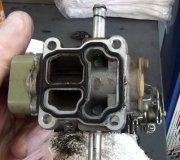I have a suspicion you are getting wrapped around the axle and over-thinking this. First, please elaborate on what "idles like crazy" means. Is the idle speed too fast, too slow, erratic, etc. The sucking noise you are hearing could just be the normal sound heard near the automatic idle speed motor when it opens the valve to get idle speed up. That is usually the result of the Engine Computer trying to overcome a low idle speed caused by something unrelated, like a misfiring cylinder.
Do you have access to a scanner? If you do, look under "Inputs/Outputs, or some similar menu, for actual "idle speed steps" or "desired idle speed steps. That will be a number between 0 and 256. For a properly-running engine, you'll typically find that around step 32. The higher the number, the more the computer is trying to increase idle speed. We will also want to look at if actual idle speed agrees with the step number to tell us if actual idle speed is too high or too low, and whether the computer is trying or not trying to correct it and with or without success.
The idle speed motors have a very low failure rate. They can fail electrically, which is not common because an internal wire would have to break, and these use pretty large wires inside, or it would have to become stuck. If you observe idle speed changing at all, the motor is not stuck. Years ago we had trouble with the air passage becoming plugged with carbon, but that was mainly on the 3.0L engine used in front-wheel-drive minivans and cars. With the better additives in today's gas, we do not see that anymore.
If you remove the motor, you can squeeze really hard to make the pintle valve retract. If you reinstall it that way, idle speed may be too high the next time you start the engine, then it should slowly come down to normal. You can also pull the pintle valve out by hand, but you do have to be pretty strong to do so. You should also see the valve move in and out a little when a helper turns the ignition switch on. The computer has no way of knowing how far that valve is in or out, so when you turn the ignition switch on, it runs the valve fully-out and then some to insure it is fully-closed and it knows where it is starting from, then it opens it roughly fifty steps to give you the nice "idle flare-up to 1,500 rpm at start-up. If you see that movement in the valve, the unit is working.
The part number for the automatic idle speed motor changed a few times over the years as they were improved and if the plug was oriented differently, but they almost all interchanged. One thing you do need to be aware of is the bolts are held in with Lock-Tight. You need a Torx bit to remove the bolts. Be sure to use the correct size and that it is fully seated, to prevent stripping the holes and rounding them out.
Tuesday, August 21st, 2018 AT 8:04 PM



